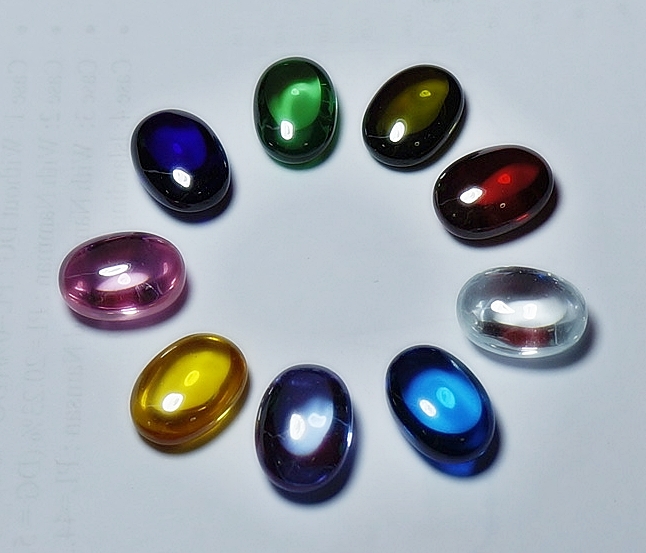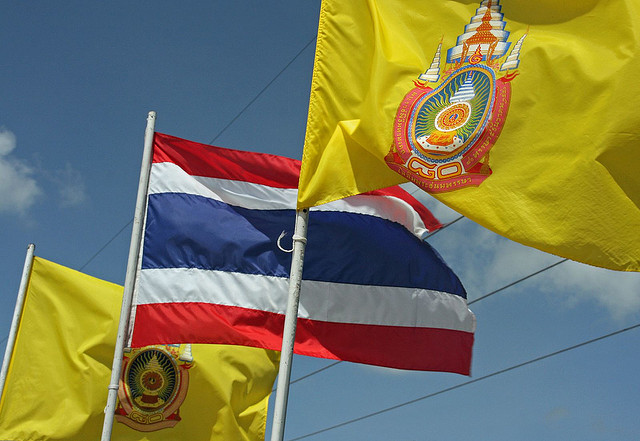
Thais are a very superstitious people and there are many superstitious beliefs and customs that have long been observed in Thailand. Some superstitions are about good luck and some are about bad luck.
Did you know that in Thailand there’s an auspicious colour for every day of the week?
As you can imagine, this tradition is no longer popular among young Thais, but many more traditional Thais still know the colours and when to wear them.
Days are marked by colours and are said to have hidden and secretive meanings. These colours influence the daily lives of people, not because of belief alone, but because many Thais feel that colour influences their perceptions and feelings.
Here’s what the colours represent from a historical and religious view:
Sunday = Red: According to historical records, there is mystic belief that Phra Isuan, a high God in the Hindu faith, since the beginning of the universe, captured six lions and ground them into powder. He then wrapped the powder with red cloth and sprinkled Nam Amarit or holy water on to the powder and thus created the Sun.
Monday = Yellow: Yellow is believed to be lucky for all occasions. According to Hindu mythology, Phra Isuan had captured 14 angels and used his infinite powers to turn them into powder. He then wrapped the powder in a yellow cloth and sprinkled holy water upon the powder creating the Moon.
Tuesday = Pink: Phra Isuan caught eight buffaloes and used his magical powers to turn them into powder, which he wrapped with soft reddish cloth and sprinkled with holy water, thus creating the Planet of Saturn.
Wednesday = Green: Green is worn on Wednesday because it is said that Phra Isuan rounded up 17 mystic elephants and turned them into powder which he wrapped with a green leaf. After sprinkling holy water he created the planet of Pluto.
Thursday = Orange: 19 hermits were powdered by Phra Isuan and wrapped in a reddish orange cloth, thus creating the Planet of Mars.
Friday = Light Blue: On this day, Phra Isuan used his powers to turn 21 bullocks into powder, wrapped them with a light blue cloth and sprinkled holy water to create the planet Venus.
Saturday = Purple: On Saturday, Phra Isuan caught 10 tigers, sprinkled powder on them, wrapped them in a purple cloth and created the planet Saturn.
| Day |
Lucky Colour |
Unlucky Colour |
Celestial Body |
God |
| Sun |
Red |
Blue |
Sun |
Surya |
| Mon |
Yellow |
Red |
Moon |
Chandra |
| Tues |
Pink |
Yellow & White |
Mars |
Mangala |
| Wed (day) |
Green |
Pink |
Mercury |
Budha |
| Wed (night) |
Grey |
Orange & Red |
None |
Rahu |
| Thurs |
Orange |
Purple |
Jupiter |
Brihaspati |
| Fri |
Light Blue |
Black & Dark Blue |
Venus |
Shukra |
| Sat |
Purple |
Green |
Saturn |
Shani |
The day of the week a person was born is very significant in Thai culture, historically. Each day has a lucky color.
In the past, many people would wear the colour associated with that day. It doesn’t happen so much now, but there are still signs of the old tradition to be found. The most noticeable of these is on Mondays where tourists will see many Thai people wearing yellow. The present Thai King was born on a Monday and wearing yellow on that day acknowledges the day which he was born. The King’s flag is also yellow for the same reason.

In recent years, the political protests have thrown a kink into the colour schemes. Since the anti-government groups have taken the colour of red (aka the “red shirts”), and the pro-government groups have taken the colour of yellow (aka the “yellow shirts”), the King decided to wear pink at a recent coronation.
In fact, there are some who say that the King’s lucky colour is actually pink, not yellow. You see, the King was born in Cambridge, Massachusetts and while his date of birth in the US fell on a Monday, it was actually already Tuesday in Thailand.
So when in Thailand, choose your colours carefully. From a business perspective, it’s appreciated when doing in business in Thailand that you recognise their culture. If you have business meetings on a Monday, consider wearing something yellow. Thais believe that wearing the right colour on the right day would bring luck. Though most people don’t really seem to follow this practice anymore, some still wear or carry a small piece of clothing, like a tie or handkerchief, which is of the correct colour for the day.
References:
http://www.examiner.com/article/the-meaning-of-color-thailand
http://www.thaizer.com/culture-shock/thailand-a-color-for-every-day/
http://iluvthailand.wordpress.com/2008/06/28/thai-superstitions-about-color/
http://en.wikipedia.org/wiki/Colors_of_the_day_in_Thailand
http://first2board.com/verygoodpoints/color/
Did you know that in Thailand, there’s an auspicous color for every…
Thais are a very superstitious people and there are many superstitious beliefs and customs that have long been observed in Thailand. Some superstitions are about good luck and some are about bad luck.
Did you know that in Thailand there’s an auspicious colour for every day of the week?
As you can imagine, this tradition is no longer popular among young Thais, but many more traditional Thais still know the colours and when to wear them.
Days are marked by colours and are said to have hidden and secretive meanings. These colours influence the daily lives of people, not because of belief alone, but because many Thais feel that colour influences their perceptions and feelings.
Here’s what the colours represent from a historical and religious view:
Sunday = Red: According to historical records, there is mystic belief that Phra Isuan, a high God in the Hindu faith, since the beginning of the universe, captured six lions and ground them into powder. He then wrapped the powder with red cloth and sprinkled Nam Amarit or holy water on to the powder and thus created the Sun.
Monday = Yellow: Yellow is believed to be lucky for all occasions. According to Hindu mythology, Phra Isuan had captured 14 angels and used his infinite powers to turn them into powder. He then wrapped the powder in a yellow cloth and sprinkled holy water upon the powder creating the Moon.
Tuesday = Pink: Phra Isuan caught eight buffaloes and used his magical powers to turn them into powder, which he wrapped with soft reddish cloth and sprinkled with holy water, thus creating the Planet of Saturn.
Wednesday = Green: Green is worn on Wednesday because it is said that Phra Isuan rounded up 17 mystic elephants and turned them into powder which he wrapped with a green leaf. After sprinkling holy water he created the planet of Pluto.
Thursday = Orange: 19 hermits were powdered by Phra Isuan and wrapped in a reddish orange cloth, thus creating the Planet of Mars.
Friday = Light Blue: On this day, Phra Isuan used his powers to turn 21 bullocks into powder, wrapped them with a light blue cloth and sprinkled holy water to create the planet Venus.
Saturday = Purple: On Saturday, Phra Isuan caught 10 tigers, sprinkled powder on them, wrapped them in a purple cloth and created the planet Saturn.
The day of the week a person was born is very significant in Thai culture, historically. Each day has a lucky color.
In the past, many people would wear the colour associated with that day. It doesn’t happen so much now, but there are still signs of the old tradition to be found. The most noticeable of these is on Mondays where tourists will see many Thai people wearing yellow. The present Thai King was born on a Monday and wearing yellow on that day acknowledges the day which he was born. The King’s flag is also yellow for the same reason.
In recent years, the political protests have thrown a kink into the colour schemes. Since the anti-government groups have taken the colour of red (aka the “red shirts”), and the pro-government groups have taken the colour of yellow (aka the “yellow shirts”), the King decided to wear pink at a recent coronation.
In fact, there are some who say that the King’s lucky colour is actually pink, not yellow. You see, the King was born in Cambridge, Massachusetts and while his date of birth in the US fell on a Monday, it was actually already Tuesday in Thailand.
So when in Thailand, choose your colours carefully. From a business perspective, it’s appreciated when doing in business in Thailand that you recognise their culture. If you have business meetings on a Monday, consider wearing something yellow. Thais believe that wearing the right colour on the right day would bring luck. Though most people don’t really seem to follow this practice anymore, some still wear or carry a small piece of clothing, like a tie or handkerchief, which is of the correct colour for the day.
References:
http://www.examiner.com/article/the-meaning-of-color-thailand
http://www.thaizer.com/culture-shock/thailand-a-color-for-every-day/
http://iluvthailand.wordpress.com/2008/06/28/thai-superstitions-about-color/
http://en.wikipedia.org/wiki/Colors_of_the_day_in_Thailand
http://first2board.com/verygoodpoints/color/
Best Thai hangover cure after a night of partying…
Happy 2014!
Still nursing that pounding headache after last night’s countdown?
Try some spicy noodles.
Almost every recipe for Pad Kee Mao (ผัดขี้เมา – drunken noodles) comes with the claim that this simple dish is a good hangover cure.
But according to locals, Pad Kee Mao is best eaten while you’re in the process of drinking. Not after.
Instead, spicy noodle soup is what cures what ails you the morning after.
It comes in many forms. Yellow noodles. Glass noodles. Wide noodles. Noodles topped with beef, fish balls, pork, chicken, pigs blood or duck.
And all are made with different flavors of broth, including the all-powerful tom yum.
Many Thais claim extra spicy soup helps freshen them up by letting them sweat out some of those nasty booze toxins and shake that queasy hangover feeling. The hearty ingredients, on the other hand, tame the angry beast crying for attention in your stomach.
For some, the idea of slurping a bowl of spicy liquid when your stomach lining is already irritated is about as appealing as knocking back another five shots of tequila.
Fortunately, at Thai noodle stands you can add your own spice from a dispenser on the table (few travellers can handle the spice intensity the locals can).
Visit the nearest street noodle stand. Or, if you’re really desperate, any Thai convenience store carries cups of instant noodles, which will do the trick if you’re in a hungover pinch.
References:
http://travel.cnn.com/asias-top-hangover-cures-230961
http://www.lostbeachestravel.com/blog/the-best-thai-hang-over-cures/
http://www.walltowatch.com/view/2703/The+best+hangover+cures